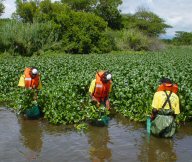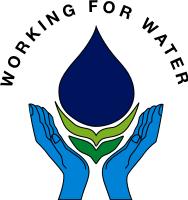|
 Invasive alien
species are causing billions of Rands of damage to South Africa’s economy every
year, and are the single biggest threat to the country’s biological
biodiversity. Invasive alien
species are causing billions of Rands of damage to South Africa’s economy every
year, and are the single biggest threat to the country’s biological
biodiversity.
Invasive alien species are plants, animals and microbes that are introduced into
countries, and then out-compete the indigenous species.
Invasive alien plants (IAPs) pose a direct threat not only to South Africa’s
biological diversity, but also to water security, the ecological functioning of
natural systems and the productive use of land. They intensify the impact of
fires and floods and increase soil erosion. IAPs can divert enormous amounts of
water from more productive uses and invasive aquatic plants, such as the water
hyacinth, effect agriculture, fisheries, transport, recreation and water supply.
Of the estimated 9000 plants introduced to this country, 198 are currently
classified as being invasive. It is estimated that these plants cover about 10%
of the country and the problem is growing at an exponential rate.
The fight against invasive alien plants is spearheaded by the Working for Water
(WfW) programme, launched in 1995 and administered through the Department of Water and Sanitation. This programme works in partnership with local
communities, to whom it provides jobs, and also with Government departments
including the Departments of Environmental Affairs and Tourism, Agriculture, and
Trade and Industry, provincial departments of agriculture, conservation and
environment, research foundations and private companies.
Since its inception in 1995, the programme has cleared more than one million
hectares of invasive alien plants providing jobs and training to approximately
20 000 people from among the most marginalized sectors of society per annum. Of
these, 52% are women.
WfW currently runs over 300 projects in all nine of South Africa’s provinces.
Scientists and field workers use a range of methods to control invasive alien
plants. These include:
- Mechanical methods - felling, removing or burning invading alien plants.
- Chemical methods - using environmentally safe herbicides.
- Biological control - using species-specific insects and diseases from the alien
plant’s country of origin. To date 76 biocontrol agents have been released in
South Africa against 40 weed species.
- Integrated control - combinations of the above three approaches. Often an
integrated approach is required in order to prevent enormous impacts.
The programme is globally recognised as one of the most outstanding
environmental conservation initiatives on the continent. It enjoys sustained
political support for its job creation efforts and the fight against poverty.
WfW considers the development of people as an essential element of environmental
conservation. Short-term contracs jobs created through the clearing activities
are undertaken, with the emphasis on endeavouring to recruite women (the target
is 60%), youth (20%) and disabled (5%). Creating an enabling environment for
skills training, it is investing in the development of communities wherever it
works. Implementing HIV and Aids projects and other socio- development
initiatives are important objectives.


|